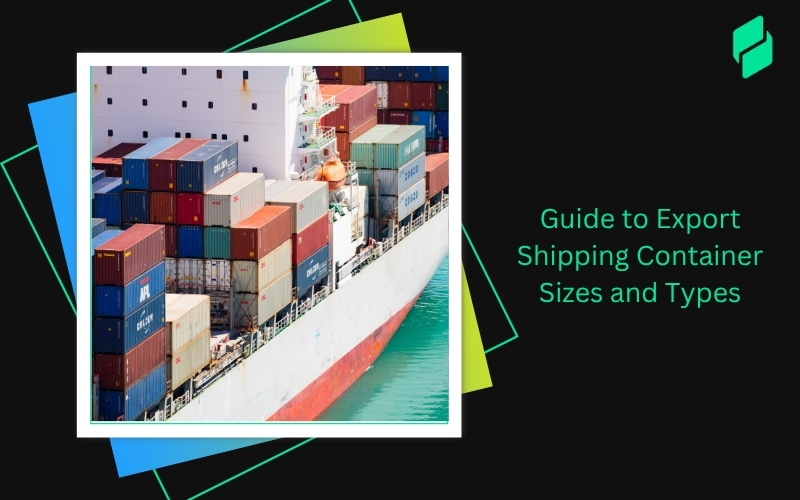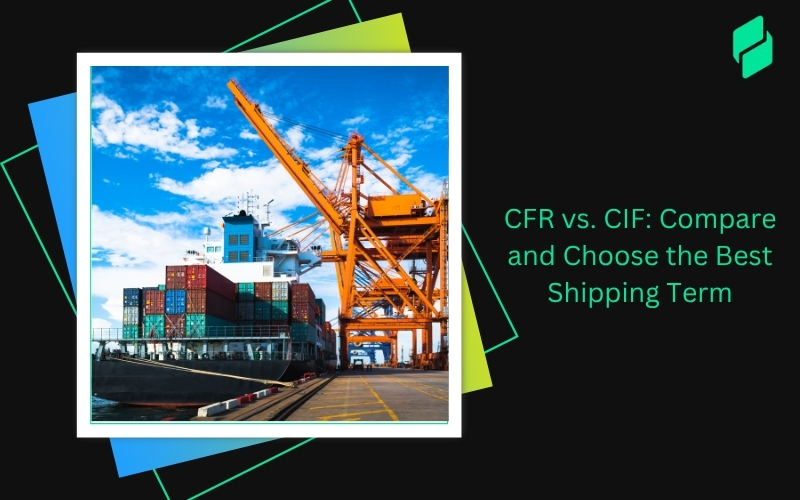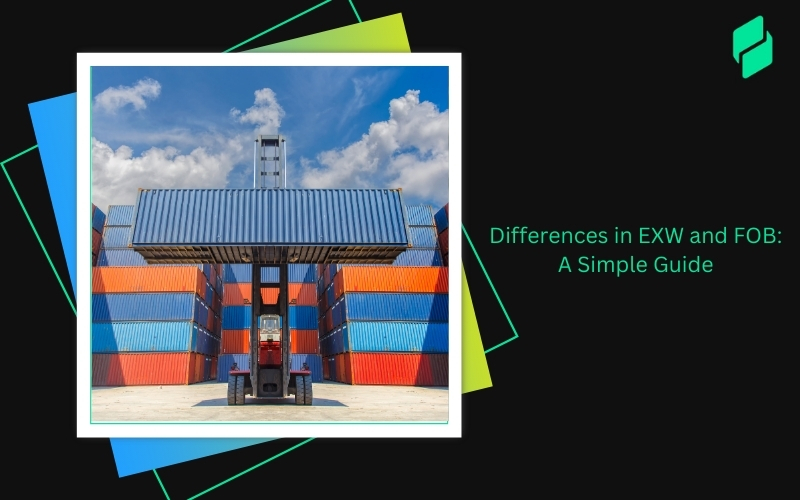Optimize your business: use unlimited savings with Pazago fulfilled now!
Get Started ->Shipping containers are integral to the global supply chain, facilitating the efficient and secure movement of goods across continents. The 20-foot container, known for its versatility and compatibility with various transportation modes, plays a pivotal role in this system.
The global container shipping market is projected to reach USD 146.79 billion by 2031, growing at a CAGR of 4.99% during the forecast period from 2024 to 2031. Understanding the specifics of the 20-foot or 20GP container is essential for international trade and logistics businesses. By learning about its dimensions, sizes, and significance, companies can optimize their shipping strategies, reduce costs, and ensure that their goods are transported efficiently across global networks.
This blog covers the specifics of the 20 GP container and gives details of its dimensions, sizes, and significance in the shipping industry. Understanding these aspects is crucial for businesses engaged in international trade and logistics, as they try to manage global shipping and supply chain management complexities.
Understanding General Purpose Containers
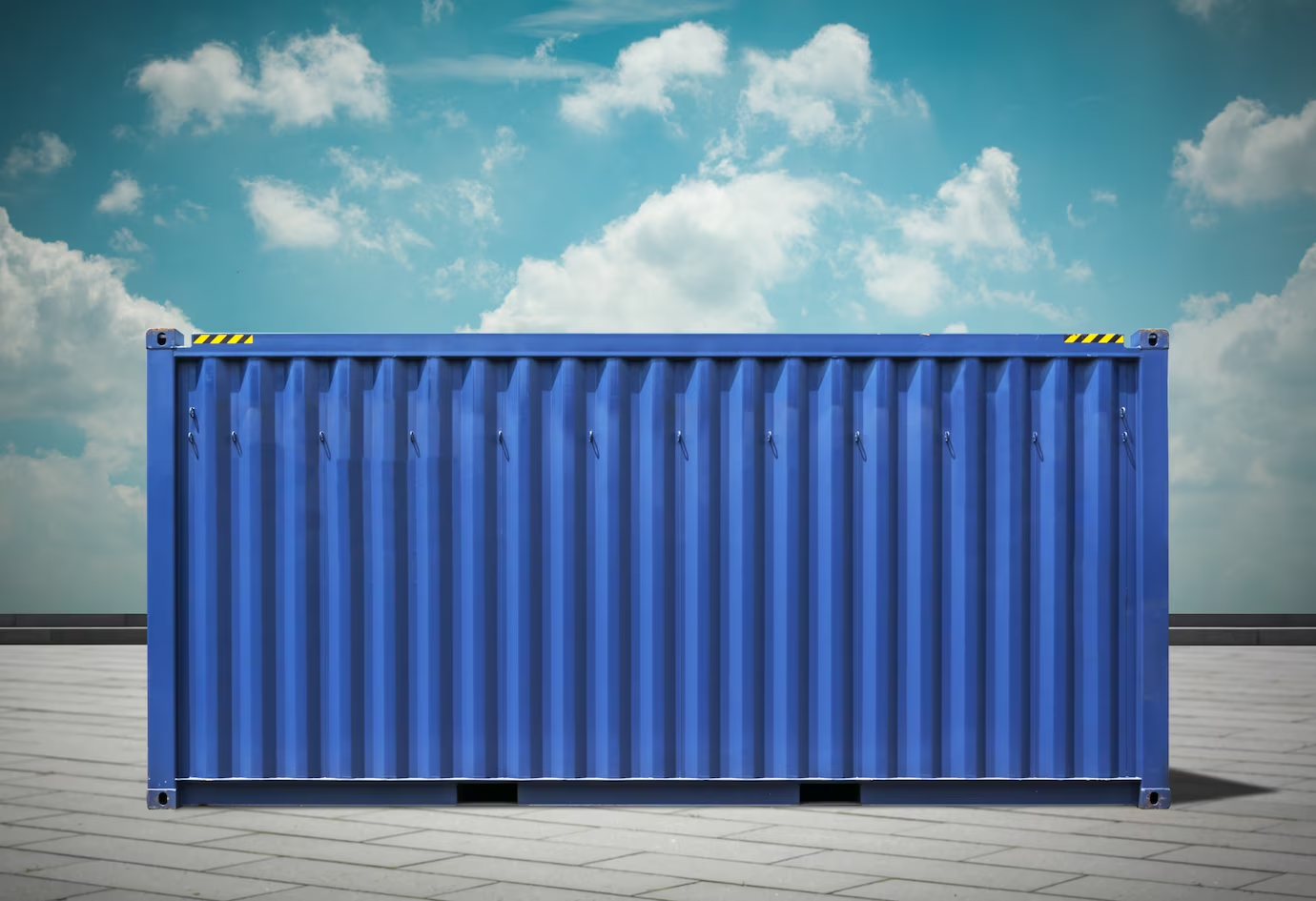
A General-Purpose (GP) container is a versatile and widely used shipping container designed to carry a wide range of goods that do not require special environmental conditions, such as temperature control or ventilation. It is a standard container typically used for general cargo that is not sensitive to weather, humidity, or other specific handling requirements.
GP containers are one of the most common containers in global trade and come in various sizes, including the widely recognized 20-foot (20GP) and 40-foot (40GP) models.
What is a 20GP Container?
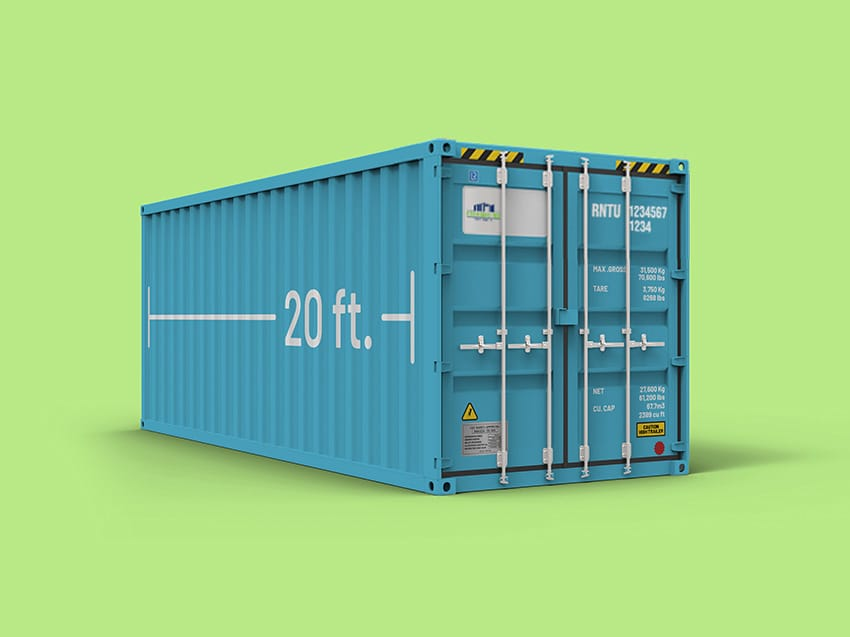
A 20GP container, or 20-foot GP container, is one of the most commonly used sizes in the shipping industry. It adheres to international standards, making it easy to handle and transport across multiple modes of transportation, such as trucks, trains, and ships.
This type of container is typically used for cargo that doesn’t require refrigeration or special conditions, providing an efficient and cost-effective option for global trade. It is designed to optimize space, minimize costs, and improve overall shipping efficiency.
Given its reliable construction and versatility, the 20GP container facilitates international trade and supply chain operations effortlessly.
Other Names for 20GP Container:
- 20ft Standard Container: This is another common name for the 20GP container, reflecting its typical use for general-purpose cargo.
- 20ft Dry Container: Sometimes referred to as a dry container, it is suitable for carrying dry cargo that doesn't require refrigeration or special conditions.
- 20ft ISO Container: Often, it’s also called an ISO container, as it meets the International Organization for Standardization (ISO) specifications, ensuring compatibility with most global shipping networks.
Common Cargo Types for 20GP Containers
A 20-foot shipping container is commonly used to transport a variety of goods, including:
- Consumer goods: Items such as clothing, furniture, and electronics, which are frequently shipped in 20-foot containers due to their compact size and versatility.
- Raw materials: Products like machinery, textiles, and metals, which are often transported in this container size for efficiency in handling and storage.
- Perishable goods: Food and beverages that require temperature control, typically shipped in refrigerated 20-foot containers (also known as reefers).
- Heavy cargo: Construction materials like cement, steel, and tiles, which are ideal for transport in 20-foot containers due to their durability and weight capacity.
This diverse range of cargo highlights the 20-foot container's ability to handle a variety of products efficiently across different industries.
Interesting Read: Containerization: Definition, Types, Advantages, and Challenges in Shipping
Differences Between 20GP and 20'HC Containers
It's essential to compare the 20GP and 20'HC containers to better understand which container type best suits your shipping needs. Each serves different purposes depending on the cargo.
A 20'HC (High Cube) container is a 20-foot container with an extra foot of height, offering more space for taller or bulkier items compared to the standard 20GP container. Understanding the differences can help you make an informed decision based on your shipment requirements.
Here’s a clear comparison of the 20GP and 20'HC (High Cube) containers, highlighting their key differences:
Now that we've defined a 20GP container, let's examine its dimensions to better understand how it fits into the broader context of shipping and logistics.
Also Read: Cost Of 40 Feet Shipping Container In India
Dimensions of 20GP Containers
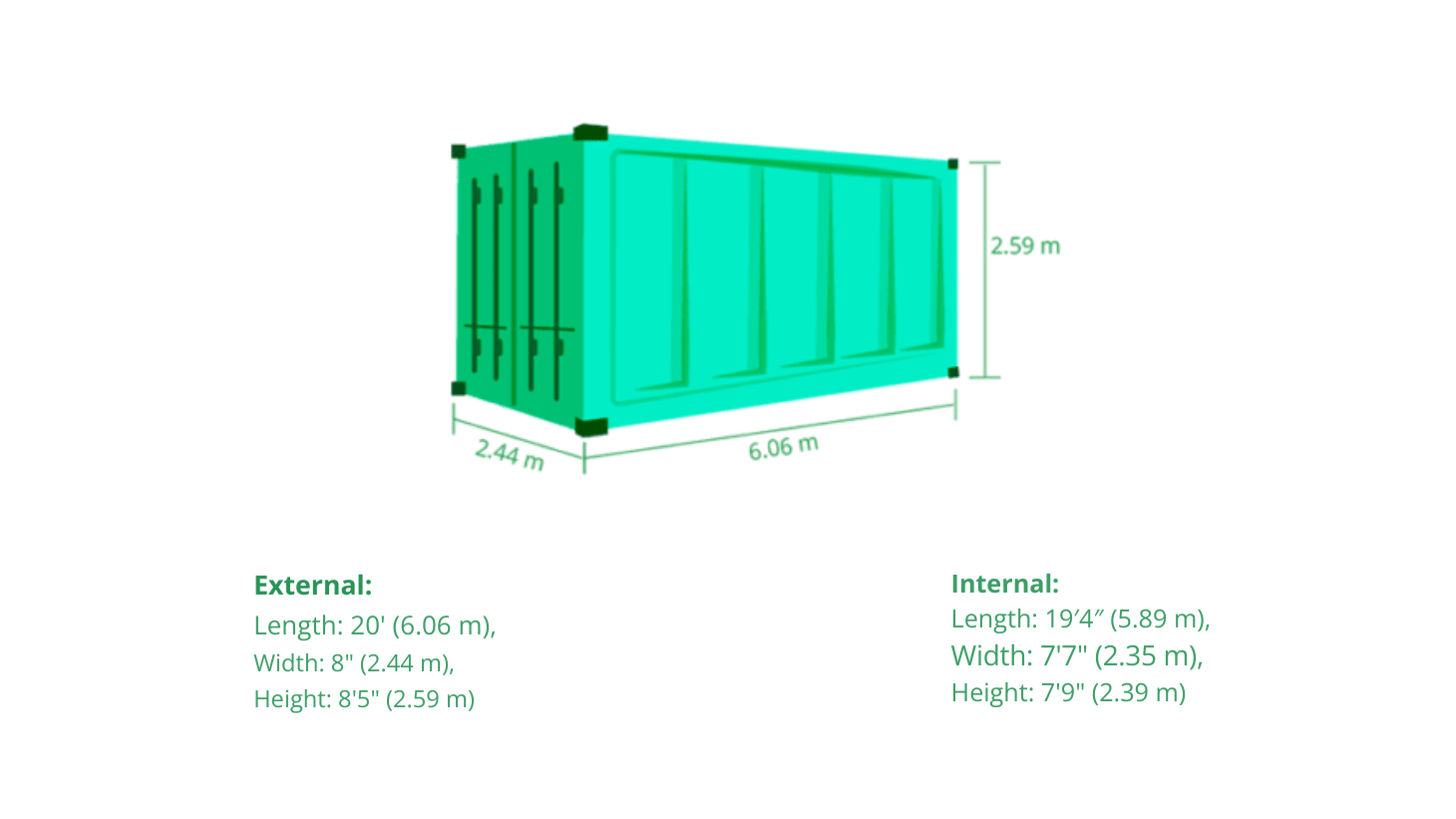
The 20-foot container has standardized dimensions that allow it to be used universally across global shipping systems. Renowned for its durability and versatility, the 20GP container provides exceptional value in shipping and when repurposed as storage or business space once it’s no longer in active use.
Here are the typical dimensions for a 20-foot container:
- External Dimensions:
- Length: 20 feet (6.058 meters)
- Width: 8 feet (2.438 meters)
- Height: 8.5 feet (2.591 meters)
- Internal Dimensions:
- Length: 19.4 feet (5.9 meters)
- Width: 7.7 feet (2.35 meters)
- Height: 7.9 feet (2.39 meters)
- Door Dimensions:
- Width: 7.6 feet (2.34 meters)
- Height: 7.5 feet (2.28 meters)
The following table highlights the dimensions and specifications of the 20GP container:
With the dimensions of a 20GP container in mind, let's look at the key features that make it an essential option for global shipping and logistics.
Also Read: Common Types of Containers for Shipping
Key Features and Advantages of 20GP Containers
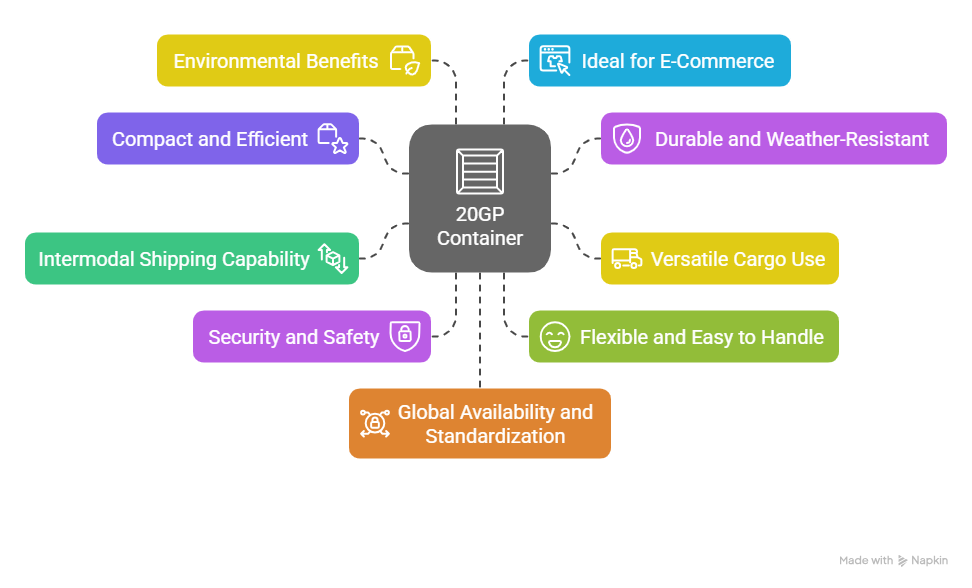
A 20GP container offers more than just standardized dimensions. It is equipped with several features that enhance its functionality and efficiency in global trade. Understanding these key features is essential for businesses looking to optimize their logistics and shipping operations.
- Compact and Efficient
With its standardized size, the 20GP container offers the perfect solution for small to medium-sized shipments. Its compact design ensures optimal use of space, both on the vessel and in storage, while also allowing it to fit into various logistics networks.
- Durable and Weather-Resistant
Constructed primarily from steel, the 20-foot container is built to withstand tough conditions. Whether it’s saltwater exposure on long sea journeys or extreme weather in transit, its sturdy design ensures that goods are protected from the elements.
- Versatile Cargo Use
The 20GP container is designed to carry various goods, including machinery, electronics, textiles, and construction materials. It can be used for almost any type of dry cargo, and with the addition of refrigeration, it can also transport perishable goods, making it adaptable for various industries.
- Intermodal Shipping Capability
The 20GP container is an intermodal shipping solution, meaning it can be easily transferred between trucks, trains, and ships without cargo unloading. This efficient transfer system reduces handling costs and shipping time.
- Security and Safety
The container’s double doors with secure locking mechanisms ensure the cargo remains safe during transit. This security is especially important for valuable or sensitive items, as it minimizes the risk of tampering or theft.
- Flexible and Easy to Handle
The 20-foot container is easy to load, unload, and store, offering significant operational efficiency. Its relatively smaller size compared to other containers allows it to be maneuvered easily in smaller spaces like warehouses and regional ports.
- Environmental Benefits
The 20-foot container is built to last and can be reused multiple times, contributing to a more sustainable shipping process. Additionally, many used containers are repurposed for other uses, such as storage or converted into buildings.
- Ideal for E-Commerce and Smaller Businesses
For smaller businesses or those involved in e-commerce, the 20-foot container is an optimal choice for shipping small-to-medium volume orders. It offers a cost-effective solution without the need for the larger capacity of a 40-foot container, helping businesses optimize their logistics and reduce overall shipping expenses.
- Global Availability and Standardization
The 20-foot container is one of the most widely used container sizes worldwide, making it readily available at most shipping ports and logistics hubs. Its standardized design makes it compatible with nearly every global transportation network.
With a clear understanding of the key features and advantages of 20GP containers, let's now shift focus to the types of packaging that are most effective when utilizing these containers.
Types of Packaging Best Suited for a 20GP Container
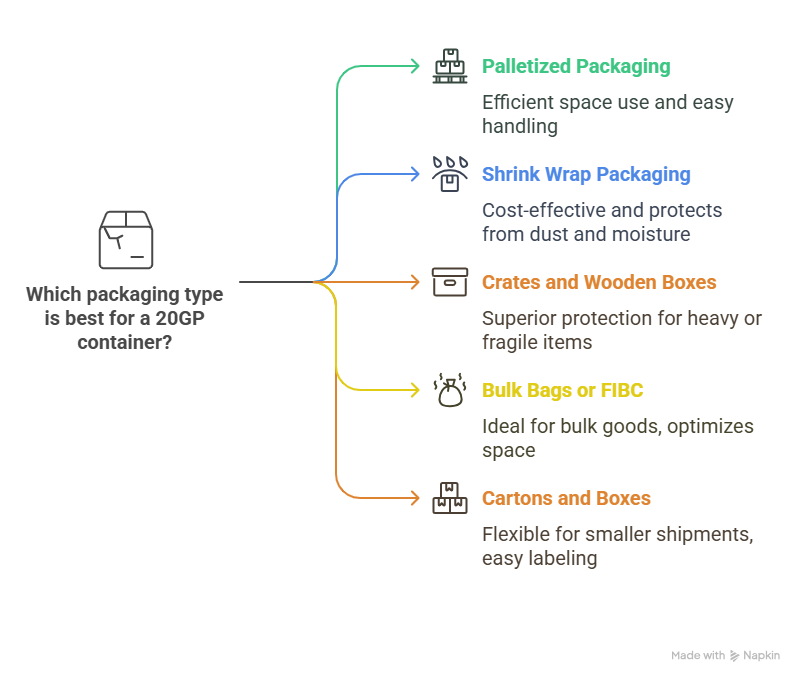
When shipping goods in a 20-foot container, choosing the proper packaging is crucial to ensure that your cargo is secure, protected, and efficiently organized to make the best use of space. Here are the types of packaging that are best suited for a 20-foot container:
- Palletized Packaging
Palletizing is highly efficient and helps maximize the use of container space. Goods are securely loaded onto pallets, which are easy to move using forklifts or pallet jacks, ensuring an efficient loading and unloading process. This method provides excellent protection and stability for most types of goods.
- Shrink Wrap Packaging
Shrink wrap tightly secures items together, minimizing shifting during transit. It’s perfect for bundling smaller items, protecting them from dust, moisture, and damage. Shrink wrapping is also a cost-effective and lightweight solution for securing cargo inside a 20-foot container.
- Crates and Wooden Boxes
For heavy, fragile, or high-value items, wooden crates provide superior protection. They safeguard goods from external damage, handling mishaps, and rough weather conditions during shipping. Crates are especially useful for oversized or oddly-shaped items.
- Bulk Bags or FIBC (Flexible Intermediate Bulk Containers)
Ideal for bulk goods like grains, chemicals, or powders, bulk bags allow efficient loading and unloading in a 20-foot container. FIBCs help to optimize container space while keeping products secure and safe from contamination.
- Cartons and Boxes
Carton packaging is flexible and ideal for smaller shipments. Stacking and organizing goods is easy, making the most of the available space in the container. Cartons also provide basic protection for items and allow for easy labeling and identification.
After examining the types of packaging best suited for a 20GP container, it's important to consider how shipping methods, like FCL and LCL, affect the overall cost of using a 20GP container.
Also Read: Domestic Container and Transportation Services in India
Impact of FCL vs LCL on 20GP Container Costs
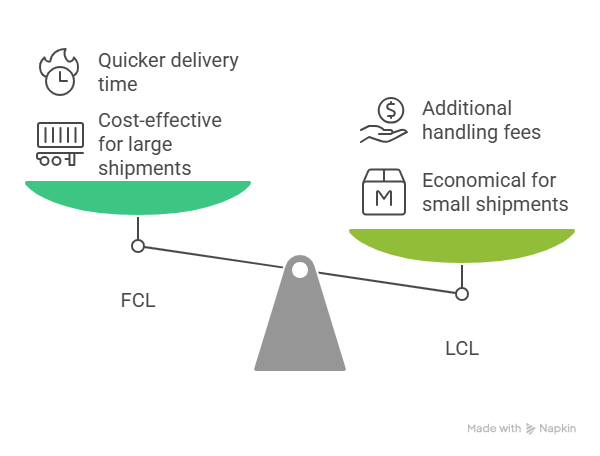
One key factor influencing the cost of using a 20-foot container is the choice of shipping method, either Full Container Load (FCL) or Less than Container Load (LCL). The shipping method you choose directly affects your shipment's overall cost, transit time, and flexibility.
- FCL
Opting for FCL means you have exclusive use of the entire 20-foot container. This method is ideal for larger shipments utilizing the container’s capacity, such as bulk shipments. Because you're not sharing space, FCL is typically more cost-effective for shipments that occupy most or all of the container's space.
- LCL
In contrast, LCL allows you to share container space with other shippers, making it an economical option for smaller shipments. With LCL, you only pay for the space your goods occupy, which can reduce costs if your cargo doesn't fill an entire container. However, LCL shipments come with additional handling and consolidation fees, as your goods must be combined with others before departure and then separated at the destination.
- Choosing Between FCL and LCL
The decision between FCL and LCL largely depends on the size and volume of your shipment. FCL is a better choice when shipping larger loads that fill most of the container, as it offers lower overall costs and quicker delivery. LCL, on the other hand, is more suitable for smaller shipments that don’t justify the cost of a full container.
However, you should be prepared for potentially higher per-unit costs, longer transit times, and additional fees for handling and consolidation.
Utilizing 20GP Container Shipments with Pazago

At Pazago, we simplify every aspect of your supply chain for 20-foot General Purpose (GP) containers, making logistics clear, efficient, and easy to manage. From shipping to inspections, our solutions keep your products safe and your business moving forward.
- End-to-End Logistics Management: We ensure reliable, fast cross-border shipping with easy coordination from origin to destination. Our system optimizes routes and guarantees timely deliveries, making 20-foot container shipments efficient and cost-effective.
- Centralized Document Management: Our secure, searchable digital repository integrates regulatory workflows to reduce errors and ensure compliance with international standards.
- 24/7 Real-Time Shipment Tracking: Receive live updates and alerts for temperature fluctuations and other critical shipment conditions. Our real-time tracking system ensures proactive action if issues arise, helping you maintain control over your 20-foot container shipments at all times.
- Efficient Communication: Our centralized platform facilitates easy communication with partners, enabling quick issue resolution and faster decision-making.
- Integrated Quality Inspections: Manage quality inspections directly from the platform, ensuring compliance with global standards for faster approvals and enhanced product quality.
- Comprehensive Cargo Insurance: With digital policy management, you can easily select the right coverage for your 20-foot container shipments, protecting against temperature excursions, theft, and damage during transit.
- Financial Simplification: We simplify cross-border payments, and our solutions enable easy financial transactions for your 20-foot container logistics.
Conclusion
The shipping industry is changing quickly, and relying on old methods for managing 20-foot container shipments isn't cutting it anymore. With rising demands and stricter regulations, adopting more innovative tools and approaches is essential to ensure your goods are delivered on time, safely, and at lower costs.
For businesses using 20-foot containers, it's time to update your processes. Sticking with outdated systems can lead to higher costs, inefficiencies, and unhappy customers. A few simple changes can greatly affect how efficiently your shipments run and how satisfied your clients are.
Looking to enhance your shipping strategy? Here's how you can improve it! Schedule a demo today and see how easy it can be to improve your logistics and stay competitive.


.png)



